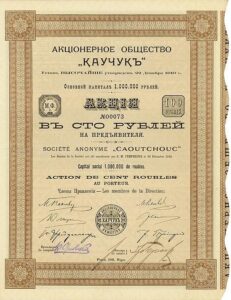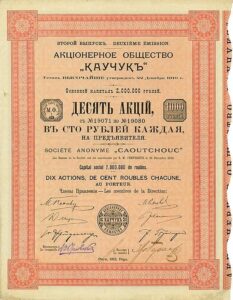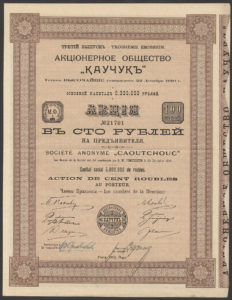
Société Anonyme “Caoutchouc”
Акционерное Общество “Каучукъ”
“Rubber” Joint Stock Company
The company was formed in 1910 with head office in Riga. Initial capital was 1,000,000 roubles in shares of 100 roubles. Capital was increased to 2,000,000 roubles in 1912 and to 5,000,000 roubles in 1913, in shares of 100 roubles.
1910 <
Description
The first Russian rubber factory owes its founding and its rise to an important cultural asset: the “galoshi”, the rubber shoes that the Russians pulled over their felt boots when the frost subsided in spring and the upper layers of earth softened, leaving mud everywhere in the Tsarist Empire, which had no sidewalks. The first and always largest rubber factory was the American-Russian rubber factory “Tre’ugolnik” in St. Petersburg, founded by the German Krauskopf in 1860. It had a capital of 21,000,000 rubles in 1913.
The second rubber factory arose with the advent of electricity and the need to produce cable insulation. This became the second largest rubber factory in Russia, the company “Provodnik” in Riga founded in 1888, with a capital (1909) of 3,500,000 rubles. In 1910, the automobile and the increasing demand for rubber tires and “pneus” gave the impetus for the foundation of two more rubber factories, the Moscow factory “Bogatyr” (capital 4,969,000 rubles) and the joint stock company “Caoutchouc” in Riga.
“Caoutchouc” was the third largest rubber factory in the country. Founding father and first chairman of the board was one of the outstanding German-born capital city bankers: Michael S. Packschwer, hereditary honorary citizen, merchant of the 2nd guild and board member of the St. Petersburg private commercial bank. He signed the 1913 share certificate. Like the legendary German banker Abs, he served on the boards of directors and boards of countless other joint stock companies, such as Lyssva Mine District of count P.P. Schuvalov’s heirs Ltd.”, the “Société de l’arrondissement de Mines Nikolae-Pavdinskoe”, the “Russian Cotton Spinning Factory”, the “Volga-Bugulma Railway” and others. (Source: HWPH, May 2010)



